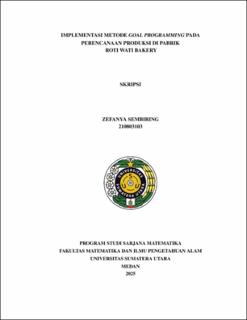| dc.description.abstract | Pabrik Roti Wati Bakery faces challenges in optimizing donut production due to raw material limitations and the imperative to maximize profit. This research implements the
Goal Programming (GP) method as a multi-objective approach to address these issues. The objectives include maximizing profit, minimizing deviations in raw material usage from targets, and meeting daily production goals. A mathematical model was developed and solved using LINGO software, utilizing data derived from raw material composition, resource availability, and product costs and profits from previous research. The
analysis reveals that Goal Programming yields a total profit of Rp7,871,000.00, with optimal production volumes encompassing 1,545 units of original donuts, 420 units of
peanut donuts, 830 units of coffee donuts, 885 units of chocolate donuts, and 620 units of chocolate peanut donuts. In comparison with the Branch and Bound (single-objective) method, Goal Programming results in a slightly lower total production (4,300 units for Goal Programming compared to 4,329 units for Branch and Bound). Nevertheless,
there is an increase in the production of original donuts (+45 units) and chocolate
peanut donuts (+132 units). This is accompanied by a reduction in peanut donuts (-132
units), coffee donuts (-3 units), and chocolate donuts (-71 units). These adjustments
signify a more targeted allocation of production towards variants contributing to more optimal profitability. The total profit generated by Goal Programming is marginally higher than that from Branch and Bound (Rp7,871,000.00 for Goal Programming against Rp7,860,100.00 for Branch and Bound). The Goal Programming method offers a superior balance in achieving production targets and optimizing raw material utilization efficiency. Consequently, Goal Programming presents an effective alternative for production planning in industries characterized by limited resources and interacting objectives. | en_US |


